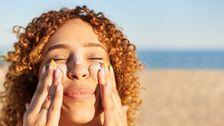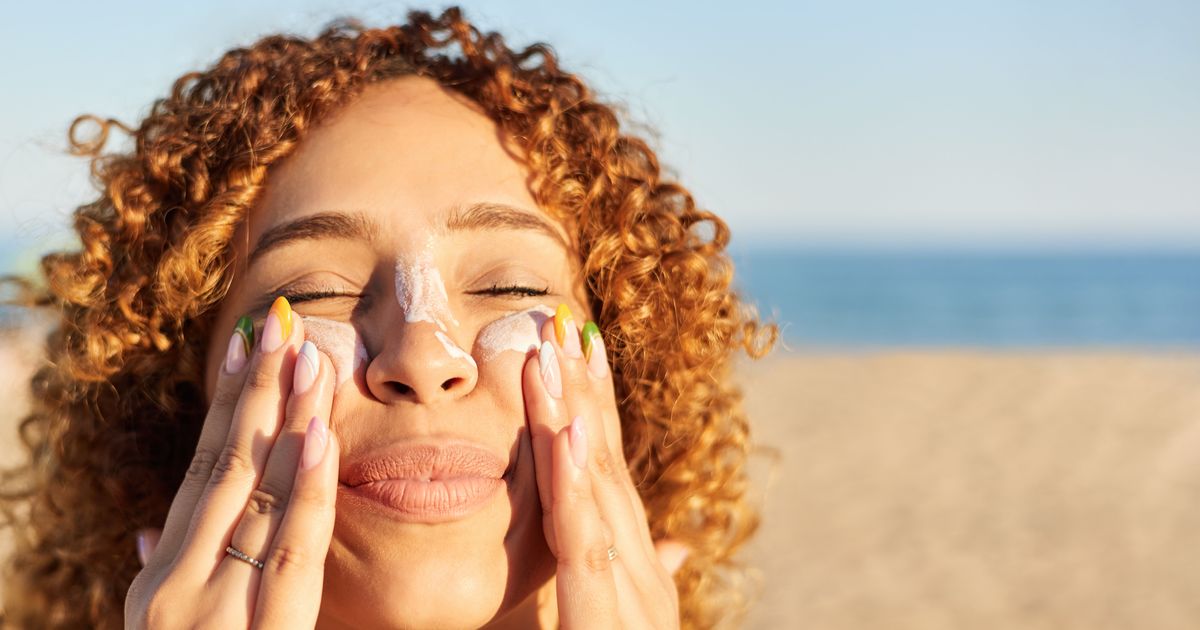
Heeding the advice of your dermatologist, you stop by the drugstore to restock on sunscreen before heading out for a day of summer fun in the sun. But in the sun care aisle, you notice something. There are the usual bottles of sunscreen you know and love. But there are also bottles of sunscreen specifically for your face — bottles that are much smaller with a much heftier price tag.
Can’t you just use body sunscreen on your face? Do you actually need separate sunscreens for your face and for your body? Or is it just a marketing tactic to encourage consumers to buy an additional product?
HuffPost spoke to two board-certified dermatologists and a cosmetic chemist to get their expert opinions, and to learn the difference between facial and body sunscreens.
What makes face sunscreen different (and more expensive) than body sunscreen?
“Most sunscreens, whether for face or body, are formulated with similar ingredient profiles,” said Dr. Angela Casey, an Ohio-based board-certified dermatologist.
So, it may stand to reason that if a product is OK to use on your body, it must be OK for your face, right? It’s important to keep in mind that the skin on your face is not the same as the skin on your body. This is why we see so many brands offer separate products for the face and body.
“Skin on the face is thinner than on the body, so it needs more protection,” explained Ginger King, a cosmetic chemist and president of Grace Kingdom Beauty.
Cosmetic chemists help provide the brains behind your favorite skin care formulations. They work to ensure that skin care products are not only effective, but also maintain their efficacy for months after they are opened.
But certain challenges can arise when formulating a product for the face.
“Sunscreen for the face will be more expensive to formulate than for the body,” King said. “Face sunscreen cannot be too greasy or leave too much of a white cast.”
Additionally, specific needs for the face (such as making a formula that doesn’t burn your eyes), as well as customer preferences, need to be taken into account.
“Oftentimes, facial sunscreens are formulated to absorb and blend easily without being too oily,” explained Dr. Elaine Kung, a New York-based board-certified dermatologist and founder of Future Bright Dermatology. “It’s common to find silica or tapioca starch in facial sunscreens because they absorb oil. Sometimes, facial sunscreens also contain skin-beneficial and anti-aging ingredients.”
The physical differences between the face and body also account for why face sunscreens are more expensive and are usually packaged in smaller containers than those for the body.
“The care area is different,” King said. “It takes a lot more sunscreen to cover the body than the face. Sunscreens also have an expiration date of one year, so a smaller size for face sunscreens makes more sense.”
The smaller size of face sunscreens also makes them easier to carry when you need to reapply on the go.
Can you use body sunscreen on your face in a pinch?
If you’re at the beach, are fresh out of your favorite face sunscreen and only have a body sunscreen on hand, can you use it on your face?
“A body sunscreen is always better than no sunscreen at all,” Casey said. “If that’s all you have, use it on all sun-exposed skin, including your face.”
While body sunscreen can provide protection, it’s better to invest in a separate face sunscreen if you can afford one — especially if you have sensitive or acne-prone skin.
Many body sunscreens may contain ingredients like coconut esters or shea butter. According to Kung, these ingredients give body sunscreen a slicker finish, but they may not be beneficial for some people’s faces.
“For people who have acne-prone skin, it’s best to avoid sunscreens that have jojoba oil, shea butter, coconut esters, silicones, or waxes,” Kung explained.
And what about the opposite? Is it OK to use face sunscreen on the body?
“In all honesty, you can use facial sunscreen on the body and body sunscreen on the face,” Kung said. The formulations generally contain similar ingredients and both are effective in their intended use ― providing protection from the sun’s harmful UV rays. But with the high cost of most facial sunscreens, it’s best to only use it on the body if you’re in a bind.
And if you have a tinted mineral sunscreen, it’s best to try to keep it away from your clothes.
“Tinted sunscreens are wonderful for the face,” Casey said. “But similar to a concealer or foundation, the sunscreen’s tint can rub onto your clothes if you apply it too far down your neck.”
What should you look for in facial sunscreen?
With all the different types of products available, what types of face sunscreen do dermatologists recommend?
“People often like chemical sunscreens because they are easier to blend into the skin,” Kung said. “The caveat is that mineral sunscreens are still more recommended for people with sensitive skin, who often get rashes.”
Chemical sunscreens use active ingredients like avobenzone, oxybenzone and octinoxate to absorb the sun’s UV rays and convert them to heat. Mineral sunscreens use active ingredients such as zinc oxide and titanium dioxide to protect the skin from UV rays by forming a physical barrier. This is why mineral sunscreens are also referred to as “physical sunscreens.”
As the active ingredients for mineral sunscreens tend to be gentler on the skin, using a mineral sunscreen instead of a chemical one is helpful to avoid the dreaded stinging that comes with using sunscreen close to the eyes.
“Users can also consider a sunscreen that has been formulated for eye skin in mind,” Kung said. “A good pair of sunglasses would be an alternative for using sunscreen directly on the eyelids for people with sensitive eyes and eyelids.”
And for those who spend much of their day in front of a screen, Casey noted that there is an additional benefit to using mineral sunscreens, particularly if they are tinted.
“Tinted sunscreens have iron oxide, which protects against blue light in addition to UV light,” Casey said. Blue light is emitted from the screens of electronics, such as phones, laptops, and tablets, and has been shown to cause skin damage.
Another reason many dermatologists also tend to recommend mineral sunscreens over chemical sunscreens is that the UV-blocking ingredients in mineral sunscreens tend to be more shelf-stable than their chemical counterparts.
“Chemical UV filters degrade more quickly than zinc and titanium oxide,” Kung said. “It’s more difficult to ensure the accurate shelf-life of chemical sunscreens, as storage during transport can also affect the longevity of sunscreens.”
A refresher on how to properly apply sunscreen this summer.
This summer, be sure to apply a broad-spectrum sunscreen that is at least 30 SPF, according to guidelines from the American Academy of Dermatology Association. Apply at least 1/2 teaspoon to your face and 1 ounce (about a full shot glass) to your bod, and reapply at least every two hours while in the sun.
And when choosing a sunscreen, whether for your face or your body, always check to make sure it protects against UVA and UVB rays.
“To really get the benefits of sunscreen, consumers need both UVA and UVB protection to prevent aging from UVA rays as well as from sunburns and cancer from UVB rays,” King said.
And lastly, it’s important to make sure that any bare patch of skin is properly protected when you’re in the sun.
“Make sure to rub in your sunscreen all the way to the hairline and around the mouth, neck, and ears to get full coverage,” Casey said. “I see way too many skin cancers along the hairline of women because they don’t get the sunscreen close enough to the hair.”

